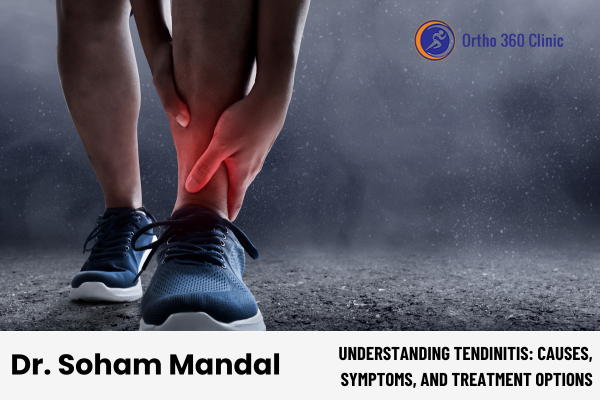Tendinitis is a common orthopedic condition characterized by the inflammation of a tendon, the fibrous tissue that connects muscles to bones. If left untreated, it can lead to chronic pain and limited movement. Dr. Soham Mandal, an expert orthopedic surgeon in Kolkata, explains the key causes, symptoms, and treatment options for tendinitis to help you manage and recover from this painful condition.
What Causes Tendinitis?
Tendinitis typically results from repetitive strain or overuse of a particular muscle group. It is especially common in individuals who engage in activities that involve repetitive motions, such as athletes, laborers, and even office workers. Other potential causes include:
- Sudden injury or trauma to the tendon
- Age-related wear and tear, making tendons less flexible
- Poor posture or improper technique during physical activities
- Inadequate stretching or warm-up before exercise
- Underlying conditions like rheumatoid arthritis or diabetes
Common Symptoms of Tendinitis
Tendinitis can affect various parts of the body, including the shoulders, elbows, wrists, knees, and ankles. The most common symptoms include:
- Pain and tenderness in the affected area, especially during movement
- Swelling and stiffness around the joint or tendon
- Reduced range of motion due to discomfort or stiffness
- A burning sensation in the area, particularly at night
If you experience these symptoms for an extended period, it’s important to consult a specialist like Dr. Soham Mandal for an accurate diagnosis and effective treatment.
Treatment Options for Tendinitis
Most cases of tendinitis can be treated with conservative methods, allowing patients to recover without the need for surgery. The treatment approach depends on the severity of the condition and the location of the affected tendon.
1. Rest and Activity Modification
Avoiding activities that aggravate the condition is crucial to preventing further injury. Resting the affected tendon helps reduce inflammation and allows for healing.
2. Ice Therapy
Applying ice packs to the affected area for 15-20 minutes at a time can help reduce swelling and ease pain. Ice should be used regularly, especially after physical activity.
3. Physical Therapy
A tailored physical therapy program can help strengthen the muscles around the tendon and improve flexibility. Stretching and strengthening exercises are essential for preventing future flare-ups.
4. Medications
Non-steroidal anti-inflammatory drugs (NSAIDs), such as ibuprofen or naproxen, may be prescribed to alleviate pain and reduce inflammation.
5. Corticosteroid Injections
In severe cases, corticosteroid injections can provide immediate pain relief and reduce inflammation. However, this is typically a short-term solution.
6. Surgery (Rare Cases)
If the tendon has significantly degenerated or ruptured, surgery may be necessary to repair the damage. Dr. Soham Mandal specializes in minimally invasive surgical techniques to ensure a faster recovery.
Preventing Tendinitis
To prevent tendinitis, it is important to:
- Warm up properly before exercise or physical activity
- Maintain good posture, especially during repetitive tasks
- Strengthen the muscles surrounding the joints
- Use proper techniques when engaging in sports or physical activities
Conclusion
Tendinitis is a manageable condition if treated early. By understanding the causes and taking preventive measures, you can avoid the long-term complications associated with it. For expert diagnosis and treatment, consult Dr. Soham Mandal, the best orthopedic surgeon in Kolkata, who specializes in treating tendinitis and other orthopedic conditions.

